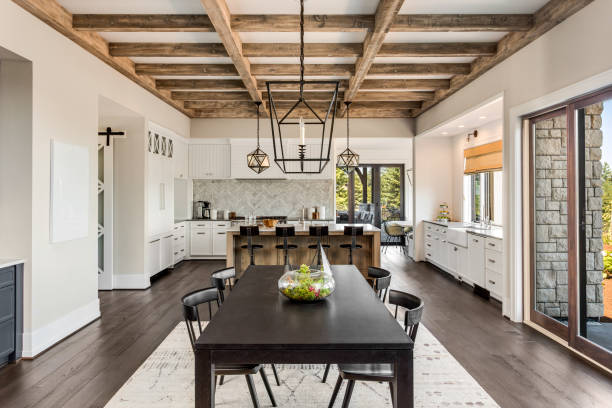Barndominiums: What to Consider Before You Build or Buy
Blending rustic charm with modern living, barndominiums have become a popular choice for those seeking spacious, customizable homes with a unique edge. But before you jump into building or buying one, it’s important to understand the design options, costs, zoning rules, and long-term upkeep involved. This article walks you through the key considerations to help you decide if a barndominium is the right fit for your lifestyle.

What Are the Key Advantages of Barndominiums?
Barndominiums stand out in the housing market for several compelling reasons. Perhaps most notably, they offer exceptional cost efficiency compared to traditional construction, with savings often ranging from 20-30% on overall building costs. This efficiency stems from simpler construction techniques and fewer materials. The open floor plan concept inherent to barn structures provides tremendous flexibility, allowing owners to design living spaces without the constraints of load-bearing interior walls.
These structures also boast impressive durability, typically featuring metal exteriors that resist weather damage, pests, and fire better than conventional wood-framed homes. The spacious interior allows for creative combinations of living areas with workshops, storage, or even indoor recreational spaces. Energy efficiency represents another significant advantage, as the building envelope can be thoroughly insulated, and the metal exterior reflects heat during summer months, potentially reducing cooling costs.
What Zoning Codes and Permits Should You Check First?
Before purchasing land or beginning construction, investigating local zoning regulations is absolutely crucial. Many municipalities have specific classifications for residential buildings, and barndominiums may fall into gray areas between agricultural, residential, or mixed-use zoning. Some areas explicitly prohibit metal buildings in residential zones, while others have minimum square footage requirements or aesthetic guidelines that could impact your plans.
Beyond zoning approval, you’ll need to secure various permits: building permits, electrical permits, plumbing permits, and potentially special permits for septic systems if you’re building in a rural area without municipal sewage. Working with local building officials early in the planning process can help identify potential regulatory obstacles. Additionally, if you’re considering building in a neighborhood with a Homeowners Association (HOA), review their covenants carefully, as many HOAs have strict guidelines about architectural styles that might exclude barndominiums.
Should You Convert an Existing Barn or Start From Scratch?
Converting an existing barn into living space offers undeniable rustic charm and potentially significant character elements like weathered wood and historical architectural details. Repurposing structures can also be environmentally friendly by reducing new material consumption. However, renovations often come with hidden challenges that can quickly erode any expected cost savings.
Building from scratch, while lacking the immediate character of a conversion, provides significant advantages: modern foundations designed specifically for residential use, proper insulation from the ground up, and electrical and plumbing systems installed without compromising structural elements. New construction also allows for precise customization of the floor plan and complete compliance with current building codes—something that can be problematic with barn conversions. The decision ultimately depends on your budget, timeline, and whether the charm of restoration outweighs the convenience and predictability of new construction.
What Design Features and Materials Define Modern Barndominiums?
Modern barndominiums typically feature metal exteriors—often corrugated steel panels—combined with thoughtful interior finishes that balance industrial elements with comfortable living spaces. Popular exterior options include wainscoting that combines metal with stone or wood accents for visual interest. Large windows are essential design elements, bringing natural light into the expansive interior spaces while creating dramatic visual contrast against the metal exterior.
For interiors, exposed structural elements like steel beams or original wooden posts create distinctive architectural features, while concrete floors—often polished or stained—provide durability and complement the industrial aesthetic. Many homeowners incorporate reclaimed materials like barn wood accent walls or vintage fixtures to enhance the rustic charm. High ceilings, particularly in great rooms, capitalize on the barn structure’s natural height, creating airy, spacious living environments. Modern barndominiums also frequently feature large sliding doors—both functional and aesthetically reminiscent of traditional barn doors—that serve as distinctive design statements.
What Barndominium Layouts Combine Rustic Charm with Contemporary Living?
Today’s most popular barndominium layouts skillfully balance open-concept living with practical separation of spaces. The most common configuration features an expansive great room that combines kitchen, dining, and living areas into one cohesive space, often with cathedral ceilings that showcase the structure’s height. This central area typically serves as the heart of the home with bedrooms and bathrooms positioned along the perimeter for privacy.
Multi-purpose designs are particularly trending, with flexible spaces that can transition between functions. Many incorporate lofted areas overlooking the main living space—providing additional square footage without expanding the footprint while adding architectural interest. Indoor-outdoor living features prominently in contemporary designs, with covered porches and outdoor kitchens that extend the living space seasonally. For those seeking work-from-home options, dedicated office spaces or workshops integrated into the main structure offer functional separation while maintaining the overall cohesiveness of the design.
What Are the Real Costs of Building a Barndominium?
When budgeting for a barndominium project, understanding the comprehensive cost structure is essential. While the shell construction offers savings compared to traditional homes, finished barndominiums still require significant investment to create comfortable living spaces.
| Component | Average Cost Range | Key Factors Affecting Price |
|---|---|---|
| Shell Structure | $20-$40 per sq ft | Metal quality, wind/snow load rating |
| Foundation | $5-$10 per sq ft | Soil conditions, frost line depth |
| Interior Finishing | $50-$100 per sq ft | Quality of materials, complexity |
| Plumbing & Electrical | $30,000-$50,000 | Distance from utilities, complexity |
| HVAC Systems | $10,000-$25,000 | Climate zone, system efficiency |
| Land & Site Prep | Highly variable | Location, topography, access to utilities |
Prices, rates, or cost estimates mentioned in this article are based on the latest available information but may change over time. Independent research is advised before making financial decisions.
The total cost for a completed barndominium typically ranges from $95 to $180 per square foot—lower than the $150 to $250 per square foot often seen with traditional custom homes, but still representing a substantial investment. Rural locations may offer land savings but could incur additional costs for utility connections, well drilling, or septic system installation. Many barndominium owners choose to complete projects in phases to manage costs, focusing first on essential living spaces while planning expansions for later stages.
While barndominiums represent a unique housing option with distinctive advantages in cost, space, and customization potential, they require careful planning around regulations, design considerations, and realistic budget expectations. By thoroughly researching these factors and understanding both the benefits and limitations of this housing type, potential owners can determine whether a barndominium truly aligns with their lifestyle goals and financial resources.




